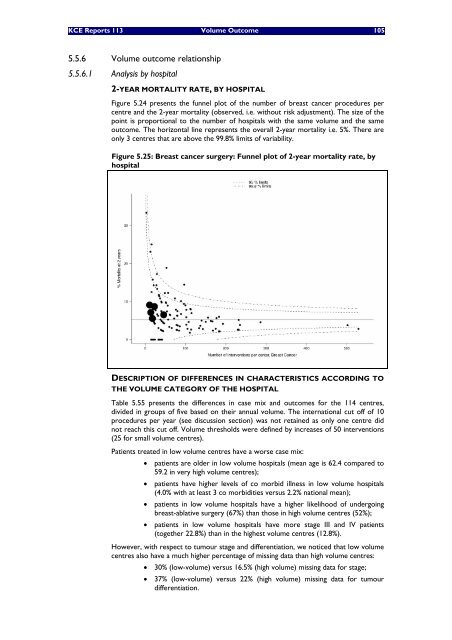Het volume van chirurgische ingrepen en de impact ervan op ... - KCE
Het volume van chirurgische ingrepen en de impact ervan op ... - KCE
Het volume van chirurgische ingrepen en de impact ervan op ... - KCE
You also want an ePaper? Increase the reach of your titles
YUMPU automatically turns print PDFs into web optimized ePapers that Google loves.
<strong>KCE</strong> Reports 113 Volume Outcome 105<br />
5.5.6 Volume outcome relationship<br />
5.5.6.1 Analysis by hospital<br />
2-YEAR MORTALITY RATE, BY HOSPITAL<br />
Figure 5.24 pres<strong>en</strong>ts the funnel plot of the number of breast cancer procedures per<br />
c<strong>en</strong>tre and the 2-year mortality (observed, i.e. without risk adjustm<strong>en</strong>t). The size of the<br />
point is pr<strong>op</strong>ortional to the number of hospitals with the same <strong>volume</strong> and the same<br />
outcome. The horizontal line repres<strong>en</strong>ts the overall 2-year mortality i.e. 5%. There are<br />
only 3 c<strong>en</strong>tres that are above the 99.8% limits of variability.<br />
Figure 5.25: Breast cancer surgery: Funnel plot of 2-year mortality rate, by<br />
hospital<br />
DESCRIPTION OF DIFFERENCES IN CHARACTERISTICS ACCORDING TO<br />
THE VOLUME CATEGORY OF THE HOSPITAL<br />
Table 5.55 pres<strong>en</strong>ts the differ<strong>en</strong>ces in case mix and outcomes for the 114 c<strong>en</strong>tres,<br />
divi<strong>de</strong>d in groups of five based on their annual <strong>volume</strong>. The international cut off of 10<br />
procedures per year (see discussion section) was not retained as only one c<strong>en</strong>tre did<br />
not reach this cut off. Volume thresholds were <strong>de</strong>fined by increases of 50 interv<strong>en</strong>tions<br />
(25 for small <strong>volume</strong> c<strong>en</strong>tres).<br />
Pati<strong>en</strong>ts treated in low <strong>volume</strong> c<strong>en</strong>tres have a worse case mix:<br />
• pati<strong>en</strong>ts are ol<strong>de</strong>r in low <strong>volume</strong> hospitals (mean age is 62.4 compared to<br />
59.2 in very high <strong>volume</strong> c<strong>en</strong>tres);<br />
• pati<strong>en</strong>ts have higher levels of co morbid illness in low <strong>volume</strong> hospitals<br />
(4.0% with at least 3 co morbidities versus 2.2% national mean);<br />
• pati<strong>en</strong>ts in low <strong>volume</strong> hospitals have a higher likelihood of un<strong>de</strong>rgoing<br />
breast-ablative surgery (67%) than those in high <strong>volume</strong> c<strong>en</strong>tres (52%);<br />
• pati<strong>en</strong>ts in low <strong>volume</strong> hospitals have more stage III and IV pati<strong>en</strong>ts<br />
(together 22.8%) than in the highest <strong>volume</strong> c<strong>en</strong>tres (12.8%).<br />
However, with respect to tumour stage and differ<strong>en</strong>tiation, we noticed that low <strong>volume</strong><br />
c<strong>en</strong>tres also have a much higher perc<strong>en</strong>tage of missing data than high <strong>volume</strong> c<strong>en</strong>tres:<br />
• 30% (low-<strong>volume</strong>) versus 16.5% (high <strong>volume</strong>) missing data for stage;<br />
• 37% (low-<strong>volume</strong>) versus 22% (high <strong>volume</strong>) missing data for tumour<br />
differ<strong>en</strong>tiation.

















